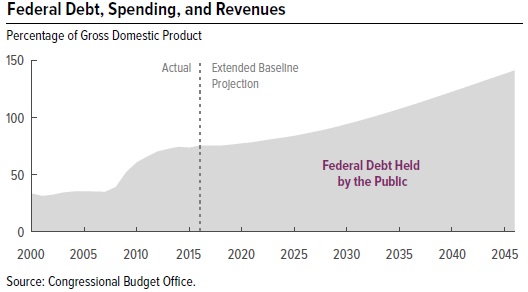By Larry Kummer*
Summary: Here is a compendium of gloomy news about America, the news that drives political campaigns, fear-mongering op-eds, and advertisements for guns and gold. These stories cloud our minds with misinformation and dampen our spirits. Why are they taken seriously by so many people? Debunkings like this are the only antidote. Pass it on!
 Today’s post examines an unusually detailed prediction of doom for America. Like most doomster writing, the content is almost entirely exaggerated or wrong, but it shows us people’s fears and ignorance — both largely fed by propaganda. The author’s key points are given in quotes.
Today’s post examines an unusually detailed prediction of doom for America. Like most doomster writing, the content is almost entirely exaggerated or wrong, but it shows us people’s fears and ignorance — both largely fed by propaganda. The author’s key points are given in quotes.
“The US Position is Untenable”
By Karsten Riise
(1) The rising US public debt will crush the US dollar
“The CBO analysis shows that Federal debt is on path to increase from 75% of GDP to 146% of GDP in 2046. …such high public debt figures are bound to lead to a fundamental crisis of non-confidence in the US dollar.”
Riise starts with the usual doomster favorite (as it has been since the New Deal): the US fiscal deficit. The wolf will always be at the door in 30 years! This is from the CBO’s 2016 Long-Term Budget Outlet. Also see the CBO’s slide deck.

These long-term predictions are useful planning tools, but range from unreliable to quite wrong. To treat them as indicators of certain doom is absurd. The many variables create a wide range of possible futures. In brief, the US government’s liabilities are among the easiest solved of America’s major problems (details here).
- The government can change policies. Small changes can have large effects for 30 years such as increased taxes and reduced military spending (need we spend more than our rivals and foes combined?).
- Forecasts of higher interest rates are one of the two major drivers of rising liabilities. The CBO’s economists assume rates will rise, as they have incorrectly assumed they would since the recovery began. Perhaps their forecast will prove correct during the next decade, or perhaps secular stagnation and low rates will continue.
- The other large driver is rising health care costs. This is among the easiest solved of America’s major problems, as our peers have built and tested many ways to provide equivalent levels of care at half or one-third the cost (details here). The transition will be painful, but at least we know the way. If only our other problems had known fixes!
The author also neglects to mention that the US government’s finances are among the best of the major developed nations. For example, its pension liabilities (for employees and public) as a percent of GDP are far lower than those of most (only Canada and Australia are lower). See figure 15 in this March 2016 research report by Citi.
“If something cannot go on forever, it will stop.”
— “Problems and Not-Problems of the American Economy” by Herbert Stein (economist) in The AEI Economist (of the American Enterprise Institute), June 1989. It is the key thing to know about the US health care system.
(2) The US is not competitive!
“The US economy is becoming less and less competitive.”
The author gives no definition or evidence for this bizarre statement, which is wrong in almost too many ways to list. First, look at growth in real GDP of the US vs. its peers. This graph from the OECD shows that the US (red) has grown slightly faster than the OECD average (black) since the crash, and is among the faster growing in the G-7 (light lines). Quite good for a large rich nation!

Second, look at a narrower measure of competitiveness: exports — an American success story since 1972 (when Nixon took the US dollar off the gold standard, reducing its over-valuation), not just growing but doing so faster than US GDP (rising from 5% to 12% of GDP).

Third, look at a leading indicator of economic growth: nationality of corporations in the fastest-growing industries. Eight of the top 13 technology companies are American; this is the pattern in most high-growth tech industries (e.g., software, internet, biotech).
“as pointed out by the economic guru Michael Porter, who also points out, that the level of bureaucracy and red-tape hindrances to business are enormous in the USA.”
The World Bank ranks all the world’s nations by “ease of doing business”. The US ranked as the 7th best in both 2014 and 2015.
(3) The US has a weak education system
“Furthermore, American public schools, hampered as they are by violence and other problems. are not exactly the best in the world. The US level of education is going down…”
The Program for International Student Assessment runs one of the best global assessments of comparative performance of national grade school systems. Their data shows that the US schools perform roughly at the OECD average. We are “not the best in the world”; our poor schools are a disgrace for one of the world’s richest nations. But ratings of the US are stable since 2000 by most measures, not “going down”.
The low rating of our grade schools is a result of inequality, as the US has some of the best schools in the OECD — and some of the worst. For more about this see “Education Gap Between Rich and Poor Is Growing Wider” in the NYT, “The Inequality in Public Schools” by Michael Godsey in the The Atlantic, and new research in “Local education inequities across U.S. revealed in new Stanford data set“.
Omitted from dirges about US education are our colleges and universities. Their large number of foreign students shows that they’re regarded as some of the best in the world.
(4) The US middle class is dying
“The middle class is disappearing in the USA, with now barely 50% of the population perceiving themselves as middle class. Median incomes have barely improved or even gone down the past 40 years, significantly reducing the middle-section of the tax base, which is normally the most reliable.”
The US middle class is dying, as is the middle class in most developed nations. See “A hollowing middle class” by Peggy Hollinger in the OECD’s Observer, and “Germany’s Middle Class Is Endangered, Too” in Bloomberg. The causes are similar to those afflicting the US.
“The American Dream is a night-mare for most Americans.”
Like most such confident assertions by doomsters, no source is given for this. There are many surveys of personal happiness and opinions about the “direction of the country”. These seldom agree with each other, or show any trend. As Dean Obeidallah shows, “We’ve Been on the Wrong Track Since 1972” — and perhaps longer (i.e., we always worry, since “only the paranoid survive”). Gallup’s “satisfaction with the United States” survey shows that peoples’ opinions have fluctuated with the economy since 1979. The Gallup-Healthways Well-Being Index shows no change since 2008.
(5) We can’t raise taxes on the rich!
“The Laffer-curve, stating that heavy tax-burdens on the rich will incur less total tax-revenues, still applies for the top-section of the US tax base. Any attempts to heavily taxate (fiscate) the upper 10% (or 0.1% !) of the US tax base will lead to US dollar capital-flight, and acute economic crisis.”
First, that’s not what the Laffer Curve means (see Wikipedia for an intro; also note Laffer’s explanation for the curve has changed over time). Second, there is no reason to believe that the current US tax structure is at the peak of the Laffer Curve (above which increases in the marginal tax rate decrease revenue). Third, research on this complex subject has given wildly different estimates for the peak rate — often in the 65-75% range (far above current peak rates).
Perhaps the most interesting contrary evidence is that that the top marginal tax bracket in the US was 70% – 90% during the high-growth decades after WWII.
(6) America’s poor just need more education
“Poor Americans lack education and training to make them competitive in the global labor-market. America’s left erroneously blames the high percentage of unemployed poor on free trade, but the real problem is the lack of education which prevents the under-class from obtaining productive jobs.”
There is no evidence that there are skill or education shortages in American, jobs ready to be filled by newly-educated poor people. For details see this, and Ignore the hype. There are few shortages of skilled workers in America. Not even the in the STEM fields.
More likely the problem is a shortage of jobs paying a living wage, let alone a wage allowing a middle class lifestyle.
(7) America’s poor at risk of starvation!
“The risk of starvation amongst the poorest in the USA remains high: In Obama’s presidency, one in seven Americans (14%) face the risk of not having enough to eat.”
This misrepresents the USDA’s conclusions. They found that in 2014 14% “had difficulty at some time during the year providing enough food for all their members due to a lack of resources” (roughly 5% of them reported losing weight). The number even remotely at risk of starvation is much smaller: “5.6 percent of U.S. households (6.9 million households) had very low food security … {where} intake of some household members was reduced and normal eating patterns were disrupted at times during the year due to limited resources” (~45% of them reported losing weight).
People starve to death in America (most estimates are several thousand per year), usually from causes other than lack of money (e.g., socially isolated children or elderly, drug abuse, mental illness). Anyone familiar with America’s poor knows that obesity is a far more widespread health problem than starvation.
(8) America’s military grows weaker!
“At the same time, the US military inventory is aging, and declining. The number of US ships and combat aircraft is declining, their average service-age goes up and their operativeness goes down. New US military hardware often take the form of useless ‘white elephants’, meaningless prestige-products like the 20-30 billion dollar Zumwalt class destroyer.
“…In absolute strength levels, the American military is standing still or going backwards. …If military budgets are not increased, the aging of the US military will be tough in the 2020’ies. …and the US military is going down in absolute as well as in relative strength.”
Other than China (playing catch-up in the great power game), the great powers are shrinking their conventional military strength. In the age in which the dominant forms of force are nukes and 4GW, conventional military power has use only in limited forms. US military spending accounts for ~37% of the world total — equal to the sum of the next 7 combined (4 of whom are our allies). While every nation’s military spending fluctuates, not only is there little evidence of America’s loss of military hegemony during the past few generations — it has grown immensely since the fall of the Soviet Union and Eastern Europe’s joining the West.
As for the Zumwalt destroyer, a trial production run cancelled after 3 ships is a bizarre basis to draw dire conclusions about the US military (continuing to build these expensive ships would have been evidence of a dysfunctional military). Also, the per ship cost was $6 billion — not $”20-30 billion” (including the program costs for a planned fleet of 32 on the 3 actually built is absurd).
(9) The US economy is unsustainable!
“The US economy is unsustainable.”
The author provides no evidence for this big assertion. Quite confident on the eve of a new industrial revolution (which might also void all the author’s other forecasts).
Note: the author does not mention one staple of the America is doomed crowd — private debt. It is high, but not unusually so vs. our peers. The US has the fourteenth highest private sector debt/GDP ratio in the OECD (2015, source here), and the fifteenth highest ratio in the OECD of household debt to net disposable income (2014, source here).
Conclusions
The Good News Is the Bad News Is Wrong
— Wonderful title to a 1984 book by Ben J. Wattenberg.
The doomster analysis of America is, yet again, not just unsupported but largely false. When reading these confident claims of End Times for America, remember that misinformation seldom just happens. It usually comes from well-paid propagandists working for special interests. These float through our minds until coalescing into predictions of doom, clouding our vision and sapping our spirits.
For More Information
- Peak Oil Doomsters debunked, end of civilization called off (2008).
- Spreading the news: the end is nigh! — A compendium of peak oil-related doomster predictions.
- Today’s conservative doomster warning (ludicrous but fun) — Paul Craig Roberts sees the End, published in the Leftist “Counterpunch”.
- The IPCC rebukes the climate doomsters. Will we listen?
- Manufacturing climate nightmares: misusing science to create horrific predictions.
- Dreams of apocalypses show the brotherhood of America’s Left & Right.
- Collapsitarians and their doomster porn.
- Journalists suffer from the crisis crisis, warping America’s vision.
* Lawrence Kummer is the editor of the Fabius Maximus website.

